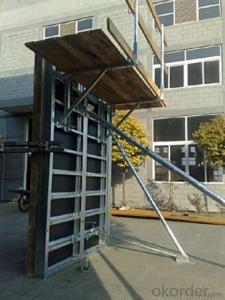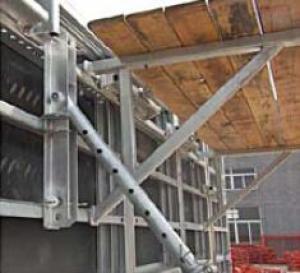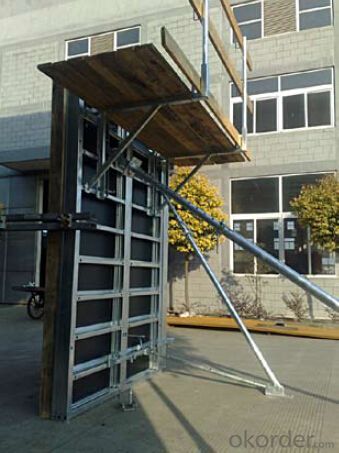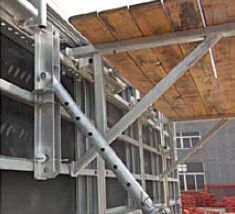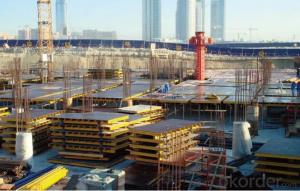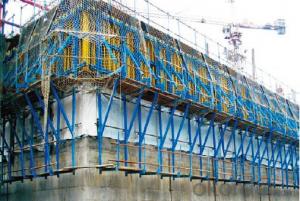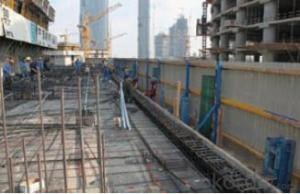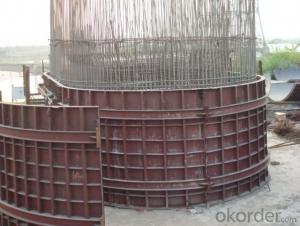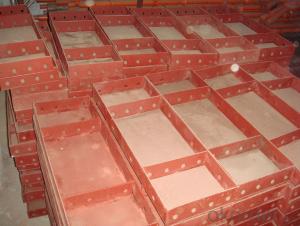Steel-frame working platformfor Formwork and Scaffolding system
- Loading Port:
- Tianjin
- Payment Terms:
- TT OR LC
- Min Order Qty:
- 50 m²
- Supply Capability:
- 1000 m²/month
OKorder Service Pledge
OKorder Financial Service
You Might Also Like
Steel-frame Formwork SF-140
Characteristics:
◆ Few parts for fast forming.
◆ Max. Concrete pressure: 80KN/m2.
◆ Hot-dip galvanized steel frame.
◆ The thickness of plywood is 18mm & the panel is 14cm.
◆ Compatibility with Hunnebeck Manto system due to similar edge profile.
System Details & Application:
◆ Neat joint and fast assembling with aligning panel clamp.
◆ Flexible panel arrangement and height extension.
◆ The selection of panels.
◆ Kinds of panel connectors.
◆ Corner clamp application.
◆ Length adjustment application.
◆ Height adjustment & aligning strut.
◆ Walkway bracket & platform.
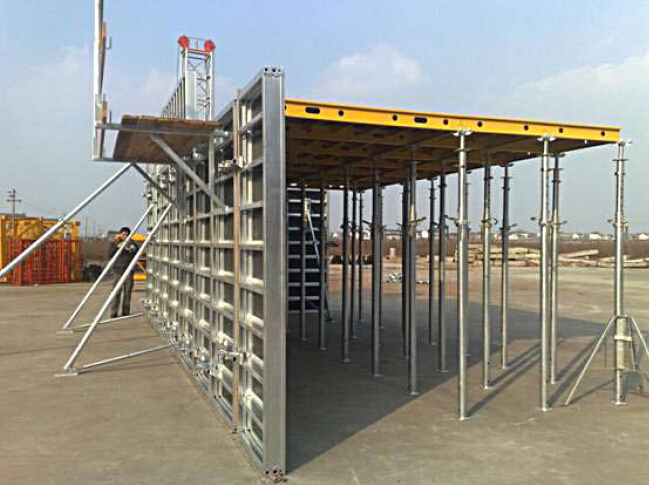

- Q: Can steel formwork be used for both standard and non-standard concrete shapes?
- Yes, steel formwork can be used for both standard and non-standard concrete shapes. Steel formwork offers flexibility and customization options, allowing it to be easily adapted to various shapes and sizes required for concrete structures. Its strength and durability make it suitable for shaping and supporting concrete in both standard and non-standard designs.
- Q: What are the different safety training requirements for steel formwork installation?
- The safety training requirements for installing steel formwork may differ depending on the regulations and guidelines established by various countries and organizations. Nevertheless, here are some typical safety training requirements that are commonly applicable: 1. All workers involved in steel formwork installation must undergo general construction safety training, which covers topics such as recognizing hazards, using personal protective equipment (PPE) correctly, fall protection, and proper lifting techniques. 2. Workers should receive specialized training on the specific techniques and procedures related to steel formwork installation. This training may include learning how to assemble and dismantle formwork properly, securing it to prevent collapse, and ensuring stability during concrete pouring. 3. Workers should be trained on operating any equipment used during steel formwork installation, such as cranes or forklifts, in a safe manner. 4. Workers should receive training on hazard communication, including understanding safety signs and labels, handling hazardous materials, and knowing how to respond to emergencies. 5. It is important for workers to be trained in first aid and CPR techniques to be prepared for any accidents or injuries that may occur during steel formwork installation. 6. If scaffolding is used during the installation process, workers should undergo scaffold safety training to understand how to assemble, use, and dismantle scaffolding safely. 7. Depending on the specific tasks involved in steel formwork installation, workers may need additional job-specific safety training. This could include training on working at heights, using power tools, or working in confined spaces. Employers and workers must comply with the relevant safety regulations and ensure that all necessary training is provided to create a safe working environment during steel formwork installation.
- Q: Can steel formwork be used for both straight and sloping structures?
- Yes, steel formwork can be used for both straight and sloping structures. Steel formwork is highly versatile and can be easily adjusted to accommodate various angles and curves, making it suitable for constructing both straight and sloping structures efficiently and effectively.
- Q: How does steel formwork contribute to the overall efficiency of construction processes?
- There are various ways in which steel formwork enhances the efficiency of construction processes. To begin with, it is highly durable and long-lasting, allowing for multiple reuses across different projects. This eliminates the frequent need for replacements, resulting in time and cost savings. Moreover, steel formwork is easily assembled and disassembled, facilitating quick setup and dismantling on construction sites. This saves valuable time during the construction phase. Additionally, steel formwork guarantees superior finishes on concrete surfaces. Its smooth and even surface ensures accurate pouring and setting of the concrete, leading to well-finished products. Consequently, the need for additional finishing work is eliminated, reducing labor costs and time. The stability and rigidity of steel formwork also prevent any deformations or movements during the pouring and setting of concrete, resulting in precise and consistent outcomes. Moreover, steel formwork offers design flexibility. Its ability to be easily customized and adjusted to various shapes and sizes allows for versatility in construction projects. This adaptability minimizes the requirement for multiple types of formwork, streamlining the construction process. Furthermore, steel formwork is resistant to adverse weather conditions, chemicals, and moisture, ensuring its durability even in harsh environments. This resistance decreases the likelihood of damage or deterioration, reducing the need for repairs and replacements. The longevity of steel formwork contributes to cost savings and enhances the overall efficiency of construction processes. In conclusion, steel formwork significantly enhances the overall efficiency of construction processes through its durability, reusability, easy assembly, high-quality finishes, design flexibility, and resistance to weather and chemicals. These advantages save time, reduce costs, and ensure the completion of construction projects efficiently and effectively.
- Q: How does steel formwork handle concrete finishing and curing agents?
- Steel formwork, a material specifically designed for concrete finishing and curing, is highly durable and versatile. Its strength and rigidity ensure a stable structure for controlled pouring and curing of concrete. During the concrete finishing stage, steel formwork allows for the smooth and even application of various finishing agents like troweling, brushing, or spraying. The smooth surface of steel formwork facilitates easy application and manipulation of these agents, resulting in a uniform and aesthetically pleasing finish. Furthermore, steel formwork is resistant to chemical reactions with concrete curing agents. These curing agents, such as sealers, compounds, or coatings, enhance the strength, durability, and appearance of freshly poured concrete. Steel formwork's non-reactive nature allows for the application and absorption of these agents by the concrete without any negative impact on the formwork material. Moreover, steel formwork is non-absorbent, meaning it does not soak up moisture from curing agents or the concrete itself. This characteristic is vital during the curing process as it allows the concrete to maintain its moisture content, ensuring proper hydration and strength development. Additionally, the non-absorbent nature of steel formwork prevents potential damage or degradation that could arise from moisture absorption, expansion, or corrosion. In conclusion, steel formwork is an excellent choice for handling concrete finishing and curing agents due to its strength, rigidity, non-reactive nature, and non-absorbent properties. It provides a stable structure for applying finishing agents while supporting proper curing and moisture retention in the concrete.
- Q: How does steel formwork handle complex geometries?
- Steel formwork is able to handle complex geometries due to its inherent strength and flexibility. The steel panels can be easily cut and shaped to fit intricate designs, allowing for the creation of complex shapes and curves. Additionally, steel formwork can be assembled and disassembled, making it highly adaptable to different geometries and construction requirements. The rigidity and stability of steel also ensure that the formwork maintains its shape during concrete pouring, resulting in precise and accurate structures. Overall, steel formwork offers the versatility and durability needed to effectively handle complex geometries in construction projects.
- Q: How does steel formwork affect the overall carbon footprint of the project?
- The overall carbon footprint of a construction project can be significantly affected by steel formwork. To begin with, the production of steel itself is a highly energy-intensive process that involves the use of fossil fuels and results in the emission of substantial amounts of greenhouse gases. The extraction and processing of raw materials like iron ore and coal also contribute to the carbon emissions associated with steel production. Furthermore, the transportation of steel formwork to the construction site adds to the carbon footprint. Due to its weight, steel requires a large amount of fuel for transportation, especially if the site is far away from the manufacturing facility. This transportation of steel formwork further contributes to the project's carbon footprint. Additionally, the lifespan and durability of steel formwork are crucial factors in its environmental impact. If the steel formwork is only used for one project and then discarded, it increases waste generation and the need for additional production and transportation of new formwork for future projects. This cycle of production and disposal further raises the carbon emissions associated with the project. Nevertheless, steel formwork does offer certain sustainability benefits that can offset its carbon footprint. Steel is a highly recyclable material, and using recycled steel in formwork production reduces the necessity for new steel production and the associated carbon emissions. Moreover, the durability of steel formwork allows for multiple uses, reducing waste generation and the carbon emissions related to disposal and replacement. To conclude, although steel formwork can contribute to a project's overall carbon footprint due to the energy-intensive production process, transportation emissions, and potential waste generation, its recyclability and durability offer opportunities to mitigate these impacts. Proper management and recycling practices can help minimize the carbon emissions associated with steel formwork and promote a more environmentally sustainable approach to construction projects.
- Q: How does steel formwork affect the overall construction productivity?
- Steel formwork revolutionizes the construction process by utilizing metal panels and supports to create temporary molds or frames for pouring concrete. This innovative technique offers numerous advantages over traditional timber formwork, including increased durability, reusability, and design flexibility. Consequently, steel formwork has a profound impact on construction productivity in multiple ways. To begin with, the utilization of steel formwork leads to heightened construction efficiency by reducing the time required for assembly and dismantling. Unlike timber formwork, steel panels are prefabricated and easily interconnected, allowing for swift installation and disassembly. This results in reduced labor hours and faster completion of formwork activities, ultimately accelerating the construction process. Moreover, the durability of steel formwork positively influences productivity. Steel panels have the ability to withstand harsh weather conditions, extreme temperatures, and heavy loads, ensuring their longevity and reusability. Consequently, contractors can reuse steel formwork on multiple projects, eliminating the need for frequent replacement and reducing material costs. The ability to reuse formwork not only saves time and money but also minimizes waste generation and promotes sustainability in the construction industry. Additionally, steel formwork offers greater flexibility in design, enabling the construction of complex structures with precision. The modular and adjustable nature of steel panels allows for easy customization according to project requirements, resulting in accurate and consistent concrete placements. This precision eliminates the need for excessive concrete rework, reducing material waste and saving construction time. The speed and accuracy provided by steel formwork positively impact overall construction productivity. Furthermore, steel formwork enhances safety on construction sites. Its sturdy structure and secure connections ensure stability during concrete pouring, minimizing the risk of accidents or structural failures. This increased safety reduces downtime caused by injuries or damages, ultimately improving productivity by maintaining a continuous workflow. In conclusion, steel formwork has a significant impact on overall construction productivity through various means. Its quick assembly and dismantling, durability, reusability, flexibility in design, and improved safety contribute to faster construction processes, reduced material waste, and enhanced efficiency. Embracing steel formwork techniques can lead to significant time and cost savings, ultimately benefiting the construction industry as a whole.
- Q: What are the considerations when designing steel formwork for dams?
- When designing steel formwork for dams, several considerations need to be taken into account. Firstly, the formwork needs to be strong and durable enough to withstand the heavy loads and pressures exerted by the concrete during pouring and curing. It should be able to resist any deformations or distortions that may occur due to these forces. Secondly, the formwork should be designed to provide a smooth and even finish to the concrete surface. This is crucial as it affects the structural integrity and aesthetics of the dam. Care should be taken to avoid any gaps or unevenness in the formwork that could result in defects or weak points in the concrete. Thirdly, the design of the formwork should allow for easy and efficient installation and removal. The formwork needs to be modular and adjustable so that it can be easily assembled and disassembled, allowing for flexibility in the construction process. Additionally, considerations should be made for proper access and safety measures for workers during the formwork installation and removal stages. Lastly, the formwork design should also take into account any specific requirements or constraints of the dam construction project, such as the shape and dimensions of the dam, the presence of any special features or structures, and any environmental or logistical considerations. Overall, designing steel formwork for dams requires careful consideration of strength, smoothness, ease of installation, and adherence to project-specific requirements.
- Q: Can steel formwork be used in tunnel construction projects?
- Yes, steel formwork can be used in tunnel construction projects. Steel formwork is known for its durability, strength, and ability to withstand high pressure and heavy loads. It can be easily assembled and disassembled, making it suitable for tunnel construction where repetitive use is required. Additionally, steel formwork provides a smooth surface finish and allows for precise shaping and molding of concrete, ensuring the structural integrity of the tunnel.
Send your message to us
Steel-frame working platformfor Formwork and Scaffolding system
- Loading Port:
- Tianjin
- Payment Terms:
- TT OR LC
- Min Order Qty:
- 50 m²
- Supply Capability:
- 1000 m²/month
OKorder Service Pledge
OKorder Financial Service
Similar products
Hot products
Hot Searches
Related keywords
